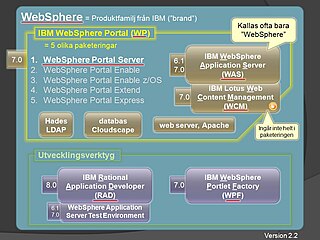
The OSGi Alliance, formerly known as the Open Services Gateway initiative, is an open standards organization founded in March 1999 that originally specified and continues to maintain the OSGi standard.
A web portal is a specially designed website that brings information from diverse sources, like emails, online forums and search engines, together in a uniform way. Usually, each information source gets its dedicated area on the page for displaying information ; often, the user can configure which ones to display. Variants of portals include mashups and intranet "dashboards" for executives and managers. The extent to which content is displayed in a "uniform way" may depend on the intended user and the intended purpose, as well as the diversity of the content. Very often design emphasis is on a certain "metaphor" for configuring and customizing the presentation of the content and the chosen implementation framework or code libraries. In addition, the role of the user in an organization may determine which content can be added to the portal or deleted from the portal configuration.
HCL Notes and HCL Domino are the client and server, respectively, of a collaborative client-server software platform formerly sold by IBM, now by HCL Technologies.

IBM WebSphere refers to a brand of proprietary computer software products in the genre of enterprise software known as "application and integration middleware". These software products are used by end-users to create and integrate applications with other applications. IBM WebSphere has been available to the general market since 1998.
Web Services for Remote Portlets (WSRP) is an OASIS-approved network protocol standard designed for communications with remote portlets.
HCL Sametime Premium is a client–server application and middleware platform that provides real-time, unified communications and collaboration for enterprises. Those capabilities include presence information, enterprise instant messaging, web conferencing, community collaboration, and telephony capabilities and integration. Currently it is developed and sold by HCL Software, a division of Indian company HCL Technologies, until 2019 by the Lotus Software division of IBM.
WebSphere Application Server (WAS) is a software product that performs the role of a web application server. More specifically, it is a software framework and middleware that hosts Java-based web applications. It is the flagship product within IBM's WebSphere software suite. It was initially created by Donald F. Ferguson, who later became CTO of Software for Dell. The first version was launched in 1998. This project was an offshoot from IBM HTTP Server team starting with Domino Go.
The Java Portlet Specification defines a contract between the portlet container and portlets and provides a convenient programming model for Java portlet developers.
A mashup, in web development, is a web page or web application that uses content from more than one source to create a single new service displayed in a single graphical interface. For example, a user could combine the addresses and photographs of their library branches with a Google map to create a map mashup. The term implies easy, fast integration, frequently using open application programming interfaces and data sources to produce enriched results that were not necessarily the original reason for producing the raw source data. The term mashup originally comes from creating something by combining elements from two or more sources.
An enterprise portal, also known as an enterprise information portal (EIP), is a framework for integrating information, people and processes across organizational boundaries in a manner similar to the more general web portals. Enterprise portals provide a secure unified access point, often in the form of a web-based user interface, and are designed to aggregate and personalize information through application-specific portlets.
OpenJPA is an open source implementation of the Java Persistence API specification. It is an object-relational mapping (ORM) solution for the Java language, which simplifies storing objects in databases. It is open-source software distributed under the Apache License 2.0.
The Sun Java System Portal Server is a component of the Sun Java Platform, Enterprise Edition, a software system that supports a wide range of enterprise computing needs.
HCL Connections is a Web 2.0 enterprise social software application developed originally by IBM and acquired by HCL Technologies in July 2019. Connections is an enterprise-collaboration platform which helps teams work more efficiently. Connections is part of HCL collaboration suite which also includes Notes / Domino, Sametime, Portal and Connections.
Oracle WebCenter is Oracle's portfolio of user engagement software products built on top of the JSF-based Oracle Application Development Framework. There are three main products that make up the WebCenter portfolio and they can be purchased together as a suite or individually:
JBoss Tools is a set of Eclipse plugins and features designed to help JBoss and JavaEE developers develop applications. It is an umbrella project for the JBoss developed plugins that will make it into JBoss Developer Studio.
HCL Commerce is a software platform framework for e-commerce, including marketing, sales, customer and order processing functionality in a tailorable, integrated package. It is a single, unified platform which offers the ability to do business directly with consumers (B2C), with businesses (B2B), indirectly through channel partners, or all of these simultaneously. WebSphere Commerce is a customizable, scalable and high availability solution built on the Java - Java EE platform using open standards, such as XML, and Web services. Formerly a product of IBM, the product was sold to HCL Technologies in July 2019.
Lotus Mashups is a business mashups editor developed and distributed by IBM as part of the IBM Mashup Center system. Lotus Mashups is intended for use in professional environments, such as corporations and governments.

IBM Web Content Manager is a proprietary web content management application by the Lotus Software division of IBM.
The JBoss Enterprise Application Platform is a subscription-based/open-source Java EE-based application server runtime platform used for building, deploying, and hosting highly-transactional Java applications and services developed and maintained by Red Hat. The JBoss Enterprise Application Platform is part of Red Hat's Enterprise Middleware portfolio of software. Because it is Java-based, the JBoss application server operates across platforms; it is usable on any operating system that supports Java. JBoss Enterprise Application Platform was originally called JBoss and was developed by the eponymous company JBoss, acquired by Red Hat in 2006

